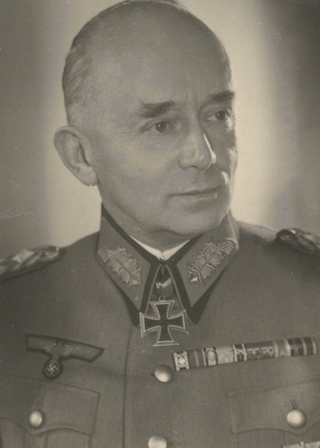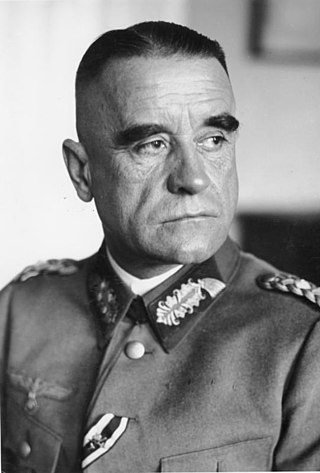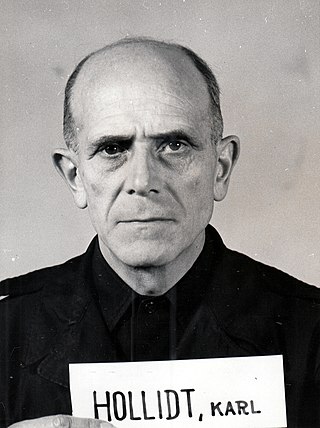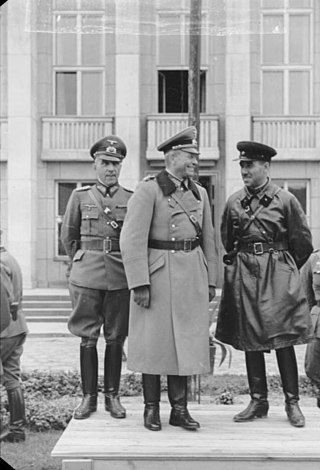
Job Wilhelm Georg Erdmann Erwin von Witzleben was a German Generalfeldmarschall in the Wehrmacht during the Second World War. A leading conspirator in the 20 July plot to assassinate Adolf Hitler, he was designated to become Commander-in-Chief of the Wehrmacht in a post-Nazi regime had the plot succeeded.

Hasso Eccard Freiherr von Manteuffel was a German baron born to the Prussian noble von Manteuffel family and was a general during World War II who commanded the 5th Panzer Army. He was a recipient of the Knight's Cross of the Iron Cross with Oak Leaves, Swords and Diamonds of Nazi Germany.

Fritz Hermann Michael Bayerlein was a "quarter-Jewish" German general in the Wehrmacht, during World War II. He initially served as a staff officer, including with Erwin Rommel in the Afrika Korps. He then commanded the 3rd Panzer Division, the Panzer Lehr Division and LIII Army Corps (Wehrmacht) in the European theatre. Bayerlein was a recipient of the Knight's Cross of the Iron Cross with Oak Leaves and Swords. Prior to the second world war, Bayerlein served in the 9th Bavarian Reserve Division in 1917.

Dietrich Kraiss was a German general during World War II. He was a recipient of the Knight's Cross of the Iron Cross with Oak Leaves of Nazi Germany.

Bruno Bräuer was a general in the paratroop forces of Nazi Germany during World War II. He served as a commander on Crete and then commanded the 9th Paratroop Division. After the war, he was convicted of war crimes and executed, along with Friedrich-Wilhelm Müller, on the anniversary of the Axis invasion of Crete.

Friedrich-Wilhelm Müller was a general in the Wehrmacht of Nazi Germany during World War II. He led an infantry regiment in the early stages of the war and by 1943 was commander of the 22nd Air Landing Division. Under his orders, troops of the division committed atrocities against Greek civilians. He was later commander of occupied Crete and his harsh methods of controlling the island saw him nicknamed "The Butcher of Crete." After the war he was convicted and executed by a Greek court for war crimes.
Heinrich Diepold Georg Freiherr von Lüttwitz was a Prussian Junker, Olympic equestrian, and German officer who served in both World Wars, retiring as a General der Panzertruppe. Lüttwitz's team competed at the 1936 Summer games in Berlin but they came away without a medal. This failure was viewed as a disgrace by the Nazi regime and, as a consequence, he was left in professional obscurity for the next few years. He eventually went on to command two Panzer Divisions and the XLVII. Panzerkorps, where he earned infamy for his demand of the surrender of the American 101st Airborne Division.

Karl Richard Ruoff was a general in the Wehrmacht of Nazi Germany during World War II. He commanded the 4th Panzer Army and the 17th Army on the Eastern Front.

Karl Hubert Lanz was a German general during the Second World War, in which he led units in the Eastern Front and in the Balkans. After the war, he was tried for war crimes and convicted in the Southeast Case, specifically for several atrocities committed by units under his command in the Balkans. Released in 1951, he joined the liberal Free Democratic Party and served as its adviser on military and security issues.

Rudolf Schmidt was a general in the Wehrmacht of Nazi Germany during World War II who commanded the 2nd Panzer Army on the Eastern Front. He was a recipient of the Knight's Cross of the Iron Cross with Oak Leaves. He was the older brother of Hans-Thilo Schmidt, who sold secrets about the Enigma machine to the French.

Walter Heitz was a German general (Generaloberst) in the Wehrmacht during World War II. He served as President of the Reich Military Court and commanded part of the 6th Army in the Battle of Stalingrad.

Karl-Adolf Hollidt was a German army commander in World War II who was subsequently convicted of war crimes. He was a general (Generaloberst) in the Wehrmacht of Nazi Germany who commanded the 6th Army.

Maximilian Fretter-Pico was a German general during World War II. He was a recipient of the Knight's Cross of the Iron Cross with Oak Leaves of Nazi Germany.

Ernst-Eberhard Hell was a German general in the Wehrmacht during World War II. He commanded several divisions and later an army corps. He was a recipient of the Knight's Cross of the Iron Cross with Oak Leaves of Nazi Germany.
Carl Becker was a German general during World War II, who commanded several divisions. He was a recipient of the Knight's Cross of the Iron Cross with Oak Leaves of Nazi Germany.
Johann Ludwig Müller was a German general in the Wehrmacht during World War II, and a recipient of the Knight's Cross of the Iron Cross with Oak Leaves of Nazi Germany.
Gerhard Heinrich Lindemann was a German general (Generalmajor) in the Wehrmacht during World War II, and a recipient of the Knight's Cross of the Iron Cross with Oak Leaves, awarded by Nazi Germany for successful military leadership.

Mauritz von Wiktorin was an Austrian general in the Wehrmacht during World War II. He was a recipient of the Knight's Cross of the Iron Cross of Nazi Germany. Wiktorin was discharged from the army on 30 November 1944 after the 20 July Plot.

Willy Riedel was a highly decorated Major in the Wehrmacht during World War II. He was also a recipient of the Knight's Cross of the Iron Cross with Oak Leaves. The Knight's Cross, and its variants were the highest awards in the military and paramilitary forces of Nazi Germany during World War II. He was severely wounded in early 1943 by a grenade splinter and taken prisoner of war by the Soviet Army. Following World War II, he served in the National People's Army of East Germany.
Hans Schmidt was a German general during World War II. He was also a recipient of the Knight's Cross of the Iron Cross with Oak Leaves of Nazi Germany.


















